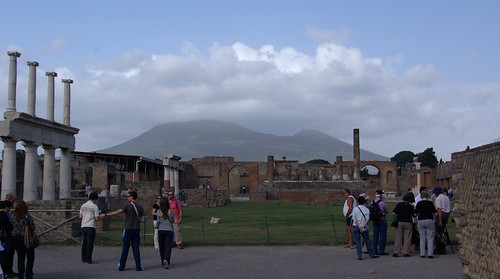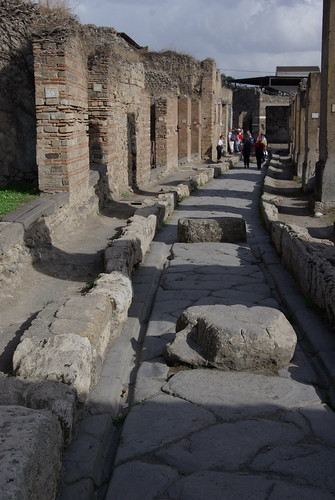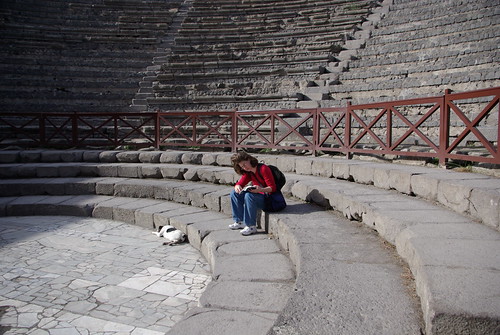The Bugle’s Photochromacommunal Promulgators prepared, especially for you, a tour of the renowned archeological site of Pompeii. On October 29th, Will and Anita took a train from Rome to Naples, and from there to Pompeii.
Pompeii was a seaside town of about twenty thousand residents in 62 CE. In the preceding seven hundred years, it had seen quite a few conquerors come and go, never able to act as an independent power. It had also felt frequent rumbles from the nearby Mount Vesuvius, but nothing that threatened the town itself. It had been generations since the last eruption of smoke and ash, and that was mainly an agricultural concern.

The conquest of the latest authorities, the Romans, happened more than one hundred years before 62 CE, and it brought some benefits. There was a new aqueduct, a military base, and a distribution network for goods that expanded the local economy.
On February 5th of 62, a major earthquake undermined most of Pompeii’s buildings and caused fires from oil lamps. Then the reservoirs broke, flooding the remnants. Chaos followed, including starvation and disease. Some residents left, but most remained, as Rome was committed to rebuilding the town. At first, construction would  stop with each of the now-frequent tremors. After more than a decade, though, the locals wouldn’t even look up from their meals during a minor event.
stop with each of the now-frequent tremors. After more than a decade, though, the locals wouldn’t even look up from their meals during a minor event.
In late summer of 79 CE, Mount Vesuvius suddenly erupted and buried Pompeii under 20 metres of rock and ash. However it happened, there was no time for the residents to prepare or flee. All was buried, and often preserved, by the eruption that would ultimately leave the entombed town kilometres inland.
Pompeii (and other towns near Vesuvius like Herculaneum) passed from local and academic memory over the centuries that followed. In 1599, a local noble dug a channel diagonally across (and above) the buried town, to bring running water to his villa. Workers found inscriptions with the word “pompei”, but the idea that they had found the lost Pompeii was considered a crackpot theory for more than 100 years.
In the 1710s, the Austrian Duc d’Elbeuf married a Neapolitan princess and decided that a villa outside Naples would be a good place to live. When a peasant found fragments marble in a newly-dug well, the Duke got excited. Antiquities were all the rage for summer homes, and he might be able to decorate his new accommodations with “brand new” stuff. His workers lifted tons of ancient goods indiscriminately, as the Duke was thrilled when a statue fit in his colour scheme and he didn’t care where it came from. It was all coming from Pompeii’s neighbour, Herculaneum.
The Duke was recalled to Austria (to his dismay) and the next owner of the villa redecorated with a new batch of booty from the town. Then, in 1746, Charles III, King of Spain, Sicily and Naples, bought the place. He wasn’t interested in social climbing, but in the prestige of his regime. Archeological wealth was, at that time, an important signifier of power. And a more careful hand was required to document the provenance of that wealth.
Charles’s excavation, led by Spanish military engineer Rocque Joaquin de Alcubierre, emptied Herculaneum. To keep production levels from the site consistent, Alcubierre expanded the area of excavation and discovered Pompeii. This began a series of excavations, to the present day, with each new arrival disgusted by the ignorance and carelessness of the predecessors.
And so we arrived, two of millions, to gawk at the once-lost town of Pompeii. The story continues at Flickr: Click here for the set from Pompeii
